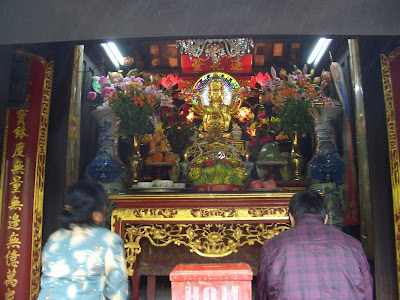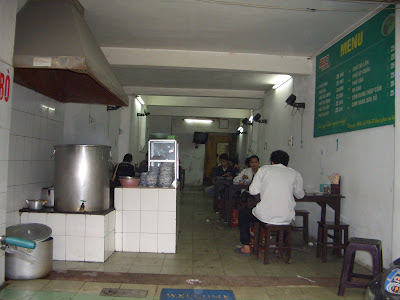One thing we kept seeing along the road were these little cemeteries - just a few headstones grouped together here and there. They were family burial grounds. Our guide told us about the interesting tradition for the funeral and burial of the deceased. One thing you should know is that the Vietnamese (80% Buddhist - and this may be a Buddhist tradition) worship their ancestors. When someone dies, the family keeps the body at their home for a day and a night while friends and relatives come to pay their respects. The family members wear white robes and headbands. The deceased family member is then buried in a coffin. After 3 years the family member is dug up. Prior to the digging up, a fortune teller is consulted who tells them exactly when to dig the family member up, based on the birth date of the deceased. The family has about an hour to wash and dry the bones and put them in a ceramic urn and rebury them. Three or four people usually help the son with this process. If there is not a son, then the family member is not dug up. A ceremony then takes place in the family home, where multiple generations live together. Our guide told us that he did that with his dad. Very interesting.
The scenery around Hoa Lu was really beautiful but the day was so overcast and it was rainy. We would have had some beautiful pictures had it been more clear. In this first photo taken at Hoa Lu, you can see fishing nets in the middle of this little lake.
We visited the temples dedicated to Emperor Dinh Tien Hoang of the Dinh Dynasty (968-80) and Emperor Le Dai Hanh of the Le Dynasty (980 - 1009). Two separate temples.
At the entrance there are usually two posts with one of their traditional symbols, the unicorn, on top.
In every temple there are one or more Buddhist statues where they worship and make sacrifices. In the one below, you can see fruit (a very typical sacrifice) and if you look closely in the bottom left corner, you can see money. It's not actually real money. They buy this fake money to sacrifice and then it is burned. Several times, while walking down the street, we saw people burning something in their yard. Our guide told us it was the fake money that they were burning as a sacrifice.
Here is a copy of the traditional shoes that these emperors wore. We saw actual photos of some of the more modern emperors in their traditional dress wearing shoes like these:
At the same location, there was the ancient Hoa Lu Citadel (Palace) which was mostly destroyed. At one time it covered 3 square kilometers (or 1.89 miles). Huge. This was all that was left....we looked down into this deep hole (excavation area) to see basically just a few stones remaining. There were some original dishes and bowls in a glass case around the big excavation area.
After viewing the temples we went to Tam Coc Town, had lunch, and then had a boat ride in this waterway surrounded by large limestone karsts that jutted out from green rice fields. The boats were called sampans, but they were basically rowboats. Here we are at the starting point waiting to board our sampan.
We could see these little statues along the way:
Really pretty and so calm and quiet even though there were a number of boats on the water.
We went into about 3 of these caves. It was really dark.
We would see a few homes along the waterway. We could also see people working in the rice fields. We even saw some mountain goats on top of some of the karsts.
Of course, at the end of the waterway when we turned around, there were the ladies in boats selling souvenirs.
After the sampan ride, we went to a local market. So interesting. The red fruit in this photo is called Dragon Fruit. We saw it everywhere. The inside fruit that you eat is white with black dots. Very interesting texture.
Meat is just laid out there on tables:
And they really do eat dog:
Our guide told us that the market is really busy in the morning and the afternoon. People go to their gardens and fields very early, pick their produce and then bring it to the market.
Or they catch what they sell. I think these eels were still alive:
After the market, we had about a 2 hour drive back to our hotel in Hanoi. Again, a really nice day.
Love to you all!
Karen




































